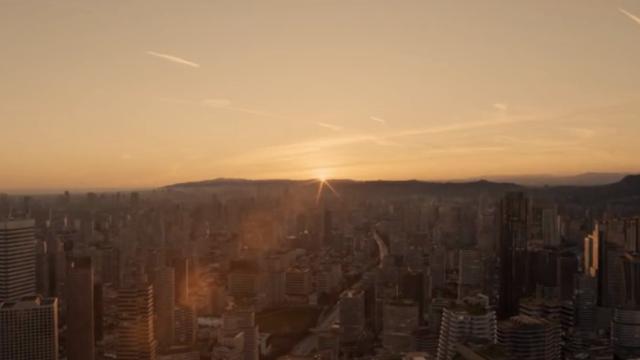Early in Spike Jonze’s new film Her, Joaquin Phoenix’s character gazes out his Los Angeles window. As the camera pans, we see not a squat, sprawling metropolis, but a golden-lit landscape of skyscrapers stretching all the way to the horizon. When I saw the film last Friday night, this scene made me gasp.
It wasn’t just the shock of seeing LA rendered as a vertical city. It was because this LA of the future looked like a place where I wanted to live.
This digitally enhanced, metastasized Los Angeles — an LA that grew up instead of out — is almost a secondary character in the film. Jonze and Her production designer K.K. Barrett consulted with architect Elizabeth Diller on the look of LA’s future, which — for once — was blissfully free of those dystopian stereotypes. Even against the bleak narrative (no spoilers, don’t worry!) the city around the characters is bustling, colourful, vibrant. It’s a gorgeous world of tall buildings, mass transit and busy footpaths.
Dare I say, this movie made density beautiful.
In real life, density remains the villain: the elephant that still looms in our dramatically urbanising cities. It is invariably what citizens battle against, as they resist development and toss around terms like “soulless towers” and “Manhattanisation”. In extreme cases, people claim that a single skyscraper can “murder” an entire city. Density is a bad word.

Future cities in Metropolis, The Fifth Element and Blade Runner
Movies haven’t helped, by the way. Future cities are either sterile, anodyne spaceships, or grimy, post-apocalyptic wastelands, invariably filled with flying cars. And all that spandex!
Beautiful density is, of course, a reality for many cities; some of Her’s most dramatic shots were filmed on the skyways and skyscrapers of Shanghai. But in LA — like many cities that aren’t Shanghai, Tokyo or New York — many people are doing everything in their power to suppress this future, citing detrimental side effects from building heights, whether it’s shadows or earthquake danger. Even some already dense cities make it impossible to secure air rights, pass ridiculous parking restrictions, and work hard to incentivise low-rise development.
But there is a huge problem looming larger than any skyscraper. Many major cities are experiencing a housing shortage which is pricing out large swaths of their populations — the workers, the creators, the young’uns. We need to start thinking big — or, rather, tall.
So how do we get our cities to grow up?
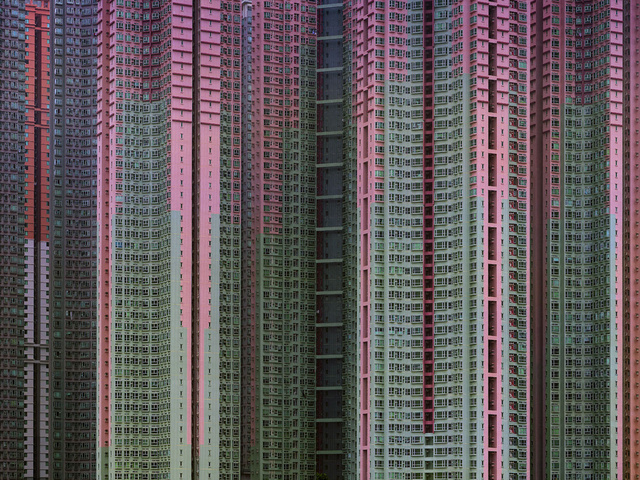
Michael Wolf’s photos of Hong Kong’s low-income housing high rises
Density’s Great (For Everyone Else!)
In theory, most of us know density is good for us — it allows us to live closer together, share resources, save energy, and stay safe. But we like the idea of skyscrapers right up until the point where one is constructed next door. Suddenly, we lament that a tall building might obscure our view, or darken our perfect afternoon sunlight. There is an ongoing sentiment that density should be for someone else. I should be able to keep my car and my yard, while my neighbours get a subway and a public park.
Anti-skyscraper urbanist Jane Jacobs argued for a “proper density”, which it can be assumed looked a lot like the typical 1960s Greenwich Village street that she canonised through her writing. With this reasoning, we’d organise all the residential buildings into neat four-storey walkups and go to work in the skyscrapers (an equation which obviously does not work out in today’s cities). Jacobs was fearful of those towers sprouting throughout Manhattan at the time, which she believe took away a neighbourhood’s diversity and sense of community.
However, that doesn’t seem to be the case. Hong Kong, which has more buildings over five hundred feet tall than any other city in the world, has been the muse of photographer Michael Wolf, who captures the towers as well as the people living inside them. These photos are shocking at first in their overwhelming scale. But 80 per cent of the residents Wolf interviewed said they were happy, thanks to the sense of community. “The important lesson to be learned is that it’s not space which is important for humans,” Wolf told Atlantic Cities. “It’s your neighbours.”
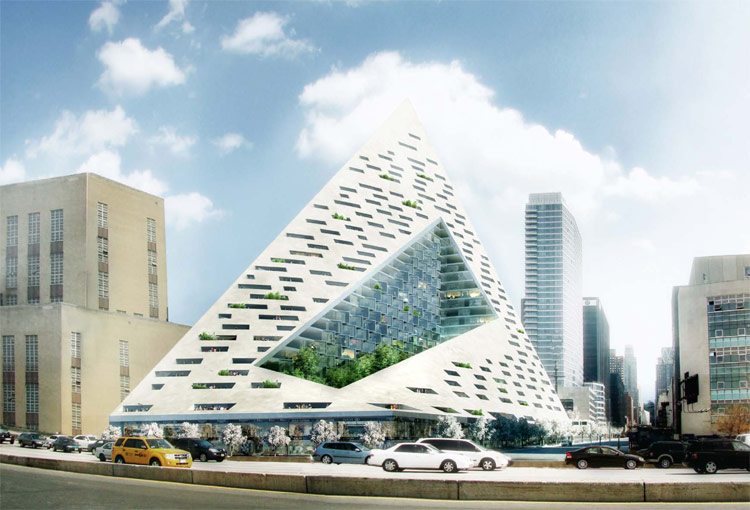
West 57, a building by BIG breaking ground soon, will bring 173 affordable housing units to Midtown Manhattan
No other building typology has done more damage to density’s image than public housing projects. The mid- and high-rise buildings erected around the world starting in the 1960s hoped to eradicate overcrowded tenements and the informal slums of inner cities, but these turned out to often become blighted areas themselves. Many of these structures were not thoughtfully designed and looked more like penitentiaries. Yet, in a documentary about the doomed Pruitt-Igoe housing project in St. Louis, the residents all talk about how it wasn’t the height or the design of the building that degraded living conditions, but about the complete breakdown of services like maintenance and security.
Affordable housing has come a long way in the intervening years, and there are now transformative examples of how high density and great design can work together to create thriving, social communities. Still, there’s another hurdle that these projects and many others have to surmount: The conventional wisdom that tall means bad.
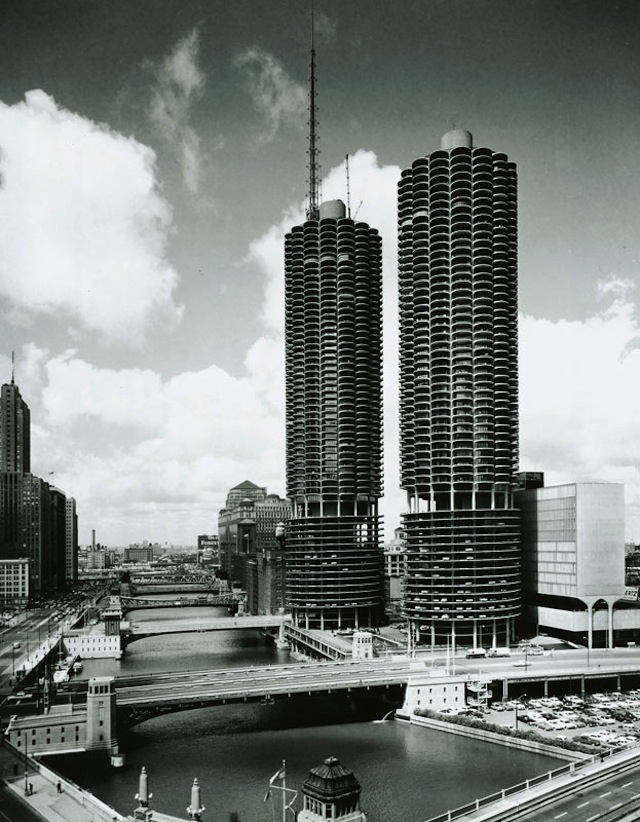
Marina City was designed by Bertrand Goldberg in 1964 to prevent white flight from downtown Chicago
Density Makes Neighbourhoods More Affordable
Think about the last time you saw the renderings on a construction site for a skyscraper poking up above the neighbouring buildings. The response is usually not very positive. When we see gleaming towers going up, we roll our eyes and talk about how everything is being ruined: “There goes the neighbourhood.”
But when a taller (residential) building goes in, it’s not driving up property values. In fact, it’s actually keeping them down because it’s increasing the housing supply. “The simple truth is that if you want home prices to drop, or even just level off, the only way to do this is to build more housing,” says Worldchanging’s founder Alex Steffen in this story on density in cities. “Desirable cities in growing regions either add housing rapidly or become unaffordable to most and socially inequitable. It’s that simple. Limiting housing supply is what drives out the poor.”
It would seem like incentivising taller, cheaper solutions would be a no-brainer for cities, especially as so many of them are trying to build more housing that can help keep growing populations of middle- and lower-income residents from leaving. Yet places like London, Washington DC and San Francisco, which are bleeding their workforces to more affordable places, still have ancient zoning restrictions that make it harder to build this kind of new, high-rise housing.
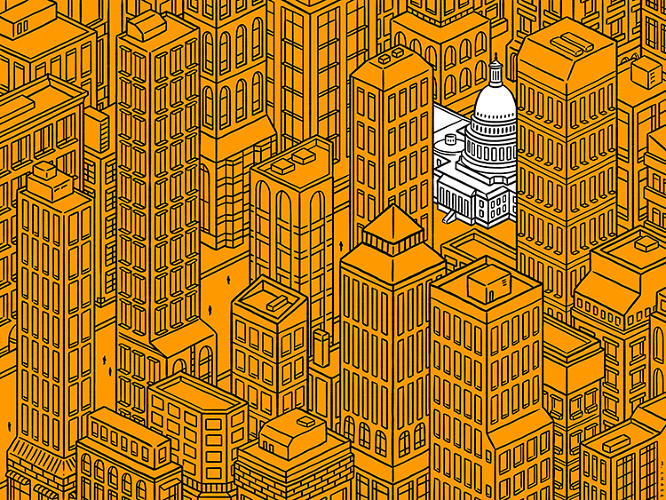
Washington DC is considering lifting its century-old restrictions on building heights, illustration by Matt Chase for Fast Company
Not only is a skyscraper better for a neighbourhood than a modest three-storey apartment building — it’s also cheaper. In a story on Overcoming Bias, Robin Hanson discovered something that’s not totally surprising once you think about it: Taller buildings actually cost less per square foot to build.
In a study that looked at costs for office buildings across 26 US cities, the higher they built, the more they saved. Buildings between 11 to 20 storeys tall saw an 11 per cent savings over the mid-rise buildings (5 to 10 storeys) and 15 per cent savings over low-rise buildings (2 to 4 storeys). Of course, most of these are basic construction savings; for example, the same type of lift and HVAC equipment are required for a certain height of building, so you’re making a big investment at a certain point that will give you a price return, of sorts. Plus, now, with advances in the prefabrication of skyscrapers, construction crews can build not only cheaper, but faster.
But think about it this way: building two four-storey buildings next to each other (assuming the property costs are similar) is going to be far more expensive than building one eight-storey tower. And, in the long term, building that eight-storey tower will cost the city more than it would have if they had just built a 16-storey tower. That’s twice the amount of residents who could have stayed in the city centre.

The 82-storey mixed-use Aqua Tower in Chicago by Studio Gang has been praised as one of the world’s most beautiful skyscrapers
Making Density Irresistible
The challenge is then handed down to the architects, developers, and planners who have to sell citizens on an upward-looking future. This doesn’t mean razing Craftsman bungalows for condo towers or turning every skyscraper into the Burj Khalifa. It’s a matter of introducing appropriate vertical growth — appropriate to the neighbourhood and the street and the existing buildings, and to what the local residents need.
But, again, we come to Jacobs’ term of “proper density”. What is the right balance? There is a major backlash against the trend of “gigantism” — building skyscrapers that are grotesquely out of proportion for a neighbourhood. These are usually luxury towers that have very little to offer their communities in the way of ground-floor services or public access. In this case, your eye rolling might be merited — these are examples of the type of density we would probably label “bad”.
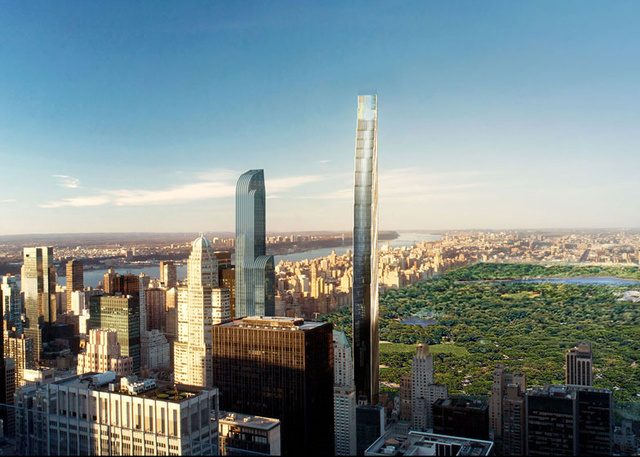
SHoP Architects and JDS Development Group have announced this 412m skyscraper at 107 West 57th. It will be the second tallest building in New York City and only 12m wide.
In New York City, four of the tallest buildings in the country are being built on the same street, West 57th. They’re all supertalls (over 300m) and all luxury towers. But here’s the thing — they’re all supertalls, yes, but thanks to ridiculous construction advances, they’re all super thin. One is only 40 feet wide. Even if it doesn’t have a restaurant or retail on the bottom floor, 12m isn’t going to do that much to disrupt the nature of the footpath below, or the views from neighbouring buildings, or even the availability of light on the ground.
Instead of fretting about height restrictions, cities should focus on mandating width-restrictions if the building isn’t providing value to the community. After all, it’s all about that street life; it’s about where that supertall touches the ground and serves its neighbours. For a luxury building, 12m wide seems about right — go as high as you want. But if it’s an affordable housing project with a preschool on the bottom floor, these are the projects we want to hold the largest footprints in our cities. They can go up and out.
Tall buildings need to create not only an aesthetic contribution to the skyline but also street-level value so they’re more likely to be embraced. But we also need to prioritise what we’re building tall: Right now, housing, in any form, should be encouraged, and cities need to work harder to allow this kind of development to occur.
While LA undergoes a major revision to its zoning code (it hasn’t been updated in 60 years), many people in our stunted city are still not convinced about the virtues of growing up. Maybe it will take some time — and a few more skyscraper-positive movies — but I’m still hoping for that beautifully dense Los Angeles of the future.
